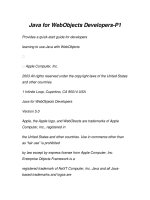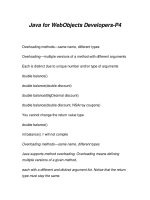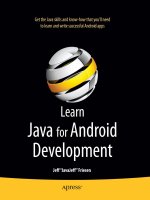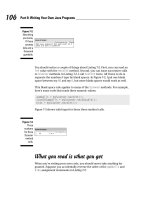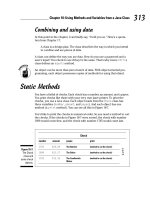Java for WebObjects Developers-P3
Bạn đang xem bản rút gọn của tài liệu. Xem và tải ngay bản đầy đủ của tài liệu tại đây (98.49 KB, 56 trang )
Java for WebObjects Developers-P3
NSArray—useful methods
You often get a pre-constructed NSArray from other objects. For
example, a shopping cart might
define a method to return all items in an NSArray. Instances of
NSArray are constant: you cannot add
or remove objects, but you can access the existing objects.
You can find out how many objects are in an NSArray using the
count() method. You retrieve an
object using an index value—an integer—as the argument to
objectAtIndex(). Recall that if
you attempt to retrieve an object using an invalid index, the NSArray
will generate an out of bounds
exception. You can also ask an NSArray if it contains a specific
object, and if so, retrieve its index
value with indexOfObject().
NSArray access methods are defined to return a generic object
reference (Object). If you need to
treat an object from an array more specifically, you must use a cast.
Unlike many arrays in traditional
languages, NSArray can store objects of any type, they do not all
have to be the same class of object.
NSArray can only store objects, not primitive types like int or double.
You cannot store a null.
The NSArray class defines many additional methods. The methods
shown here comprise a useful
subset. Consult the WebObjects foundation documentation for
details. Note in particular the
various—frequently overlooked—constructor methods which you can
use to create an NSArray
containing, for example, a single object, or a collection of objects in a
Java native array.
Java for WebObjects Developers • Chapter 2 43
NSMutableArray—useful methods
Constructing a new mutable array
NSMutableArray items = new NSMutableArray();
Adding an object
items.addObject(widget);
Removing an object
items.removeObject(widget);
Creating a new mutable array from an existing immutable array
NSArray items = shoppingCart.allItems();
NSMutableArray items2 = new NSMutableArray(items);
NSMutableArray—useful methods
An NSMutableArray responds to the same messages as an NSArray.
You can determine the count of
objects in the array, get an object at a specific index, and search for
an object to determine its index.
NSMutableArray also defines the methods addObject() and
removeObject() for adding
and removing objects respectively. When you add an object, it is
placed at the end of the array at
the next available index. When you remove an object, the array
adjusts the indices of all objects that
follow, essentially shifting them down to fill in the gap. There are
additional messages for inserting
and removing an object at a specific index.
You construct a new mutable array like you construct any Java
object. The new array is initially empty.
Its count is 0. There are no valid indices since there are no objects in
the array.
What if you need to add or remove the objects in an immutable
NSArray object? You can construct
a new NSMutableArray and initialize it with objects from the existing
NSArray. Now you can add and
remove objects using the mutable array. Although you now have two
different arrays you do not have
multiple copies of the objects they reference. Arrays contain
references not objects. You merely have
multiple references to the shared, underlying objects.
44 Chapter 2 • Java for WebObjects Developers
NSDictionary maintains a collection for efficient lookup
• Values in the collection must be objects
You access an object using a key
• The key can be any type of object, but it is usually a String
NSDictionary is similar to Java’s Hashtable
• HashMap in Java 2
NSDictionary maintains a set of key-value pairs
Widget
NSDictionary
price $9.95
Gadget
price $17.95
Sprocket
price $4.50
"key1"
"key2"
"key3"
NSDictionary maintains a set of key-value pairs
Like an NSArray, an NSDictionary maintains a collection of objects
(like NSArray, you cannot put
values of primitive types such as int or float in an NSDictionary). But
objects are not stored using
numerical indices. There is no implied ordering in an NSDictionary.
Rather, objects are associated
with keys. You access an object using its key—another object.
Usually the key is a String object where
the string value is a meaningful symbol like “name”, “email”, or
“phone number”. Dictionaries in
other languages are often called associative arrays or hashtables.
They are said to store objects as
key-value pairs.
An NSDictionary is useful for collecting objects that need to be
efficiently accessed using a symbolic
lookup key. In this sense, it is like real-world language dictionaries:
you supply the word—a lookup
key—and the dictionary returns the definition—the object value
associated with the key. Dictionaries
are implemented for efficient lookup operations. Given a key, they
can quickly locate the
corresponding value. To do this, dictionaries use a hashing
mechanism making them similar to Java’s
Hashtable class (HashMap in Java 2).
Java for WebObjects Developers • Chapter 2 45
NSDictionary is constant—you cannot add or remove objects
• NSMutableDictionary can be modified—you can add/remove keys
NSMutableDictionary is a subclass of NSDictionary
• NSMutableDictionary is a kind of NSDictionary
NSDictionary and NSMutableDictionary
NSMutableDictionary
NSDictionary
NSDictionary and NSMutableDictionary
Like arrays in WebObjects, dictionaries are implemented in two
different classes, one constant, the
other mutable. NSDictionary is constant: once the dictionary is
created, you cannot add or remove
objects.
NSMutableDictionary is a subclass of NSDictionary. It is a kind of
NSDictionary and can be treated
generically like any NSDictionary. More specifically,
NSMutableDictionary extends the NSDictionary
superclass with additional methods for adding and removing objects.
When researching
NSMutableDictionary, be sure to consult the NSDictionary
documentation as well. As with NSArray,
do not overlook the various constructor methods.
An NSMutableDictionary does not have a fixed size. You can add
new objects and the dictionary
automatically grows in size to accommodate them. An NSDictionary
does not have a concept
of bounds checking either. If you ask for an object using a key that is
not in the dictionary, the
dictionary simply returns null to indicate that there is no
corresponding object.
46 Chapter 2 • Java for WebObjects Developers
NSDictionary—useful methods
You often get a dictionary from another object
NSDictionary props = customer.properties();
Getting the current count of objects in the dictionary
int count = props.count();
Getting an object value using a key
Object name = props.objectForKey("name");
String phoneNumber =
(String)props.objectForKey("phone number");
If there is no object for that key, the dictionary returns null
String email = (String)props.objectForKey("email");
if (email != null)
// dictionary contains value for "email"
NSDictionary—useful methods
You often get a pre-constructed dictionary from another object.
Imagine that a shopping cart can
report a set of properties about itself—model name, serial number,
the vendor that built it, or that a
customer can provide a dictionary containing name, phone number,
and email address.
You can determine the number of objects in a dictionary using the
count() method. You
can get individual objects—values—from the dictionary if you know
the correct key using
objectForKey().
Like array methods, dictionary methods are declared to return generic
object references. Dictionaries
can hold any kind of object. A single dictionary often collects object
values of several different class
types: strings, dates, numbers, and custom classes like customers
and shopping carts. A generic
object reference is valid for any class type. When you get an object
from a dictionary, you typically
use a cast to treat it as a more specific class type.
Recall that if the dictionary does not contain a value for the requested
key, objectforKey()
returns null. When in doubt, check the return value. Because of this
convention, you cannot store
a null in a dictionary.
Java for WebObjects Developers • Chapter 2 47
NSMutableDictionary—useful methods
Defining and constructing a new mutable dictionary
NSMutableDictionary items =
new NSMutableDictionary();
Adding an object for a key
items.addObjectForKey(widget, "product");
Removing a value
items.removeObjectForKey("product");
Creating a new mutable dictionary from an existing dictionary
NSDictionary props = shoppingCart.properties();
NSMutableDictionary props2 =
new NSMutableDictionary(props1);
NSMutableDictionary—useful methods
You can construct a new NSMutableDictionary. Initially, it contains no
key-value pairs. Its count is 0.
Any attempts to retrieve a value will return null.
You can add a new object to the NSMutableDictionary, associating it
with the specified key, using
the method addObjectForKey(). If an object is already stored in the
dictionary for that key, it
will be replaced by the new object. You can explicitly remove an
object associated with a specific key
using the method removeObjectForKey(). Subsequent attempts to get
an object for that key
return null.
In some cases, you will want to create a mutable version of an
immutable dictionary. You can
construct a new mutable dictionary, providing the existing dictionary
as an argument to the
constructor.
Like NSArray, instances of NSDictionary do not really contain objects,
only references to objects.
48 Chapter 2 • Java for WebObjects Developers
To use a Java class, import its package
Classes are grouped into libraries or packages of related functionality
There are many classes in many different packages
• Packages that are part of the Java runtime
• Custom packages from 3rd parties or your organization
To use any class in your code, you must import its package
NSArray and NSDictionary are in the WebObjects Foundation
package
import com.webobjects.foundation.*;
The java.lang package is automatically imported
• java.lang includes basic classes like Object and String
To use a Java class, import its package
The Java runtime environment defines a large number of standard
classes that you can use to build
your applications. Products like WebObjects define even more. Your
own organization may define its
own set of reusable classes.
In Java, classes are organized into packages. A package typically
groups related classes that address
a specific set of problems. One package might provide advanced
math operations and extended
value classes. Another package provides classes for performing file
I/O. Yet another package deals
with networking. Packages make classes easier to find and to use.
They also make it easier to avoid
naming conflicts, and to control access.
In general, to use a class in your code, you must explicitly import the
package that defines it. The
import statement specifies a class name including its package name.
You can use an asterisk to
import all classes in a package. If you use a class name without also
providing an appropriate import
statement, the Java compiler generates an error specifying that it
does not recognize the class.
There is one package that is automatically imported for you:
java.lang. This is the most basic of
all packages since it defines fundamental classes like Object and
String. You do not have to explicitly
import a package when using just these basic classes.
Java for WebObjects Developers • Chapter 2 49
Iterating over the items in a collection
Use an Enumeration object with a while loop
import java.util.*; // package with Enumeration
import com.webobjects.foundation.*; // NSArray
double total = 0;
NSArray items = shoppingCart.items();
Enumeration e = items.objectEnumerator();
while (e.hasMoreElements()) {
Product item = (Product)e.nextElement();
total = total + item.price();
}
Don’t modify the collection while enumerating
Java 2 provides Iterator and ListIterator
Iterating over the items in a collection
When using a collection, you will often need to process every object it
contains. This is called
iterating over the collection or enumerating the elements of a
collection. Consider the
balance() method of a shopping cart object: it must iterate over each
of its items, get its price,
and add it to the total. Java provides two tools for getting the job
done—an Enumeration object and a
while loop. Java 2 also provides Iterator and ListIterator classes,
which supersede Enumeration.
You get the enumeration object from the collection. It returns an
object capable of enumerating
all objects currently stored in that specific collection. Objects of type
Enumeration respond to the
following messages:
• hasMoreElements()—returns true if there are more objects to visit.
• nextElement()—returns the next object in the collection.
In Java 2, the Iterator class implements the corresponding methods
hasNext() and next().
Use the enumeration object with a while loop to process each object
in the collection. The
while loop is a code block which is repeatedly executed as long as
the conditional test—a boolean
expression—evaluates to true:
while (condition) {
loop body ...
}
Java also provides for and do-until loop statements not shown here.
While using an enumeration, you should not add and remove objects
from the collection.
50 Chapter 2 • Java for WebObjects Developers
Wrapper classes turn primitives into objects
Collections only store non-null object references
• Can’t store null as a value in a collection
• Can’t store primitive types—int, float, boolean, etc.
Java defines wrapper classes for treating primitives like objects
Integer Long Float Double
Short Character Byte Boolean
Required for some method arguments and return values in other
classes
Wrapper classes are automatically imported—part of java.lang
Wrapper classes turn primitives into objects
Remember that Java is a hybrid language—not all data types are
objects. Your code often makes use
of simple values typed as int, double or boolean. In some cases,
though, you need to treat these
primitive values as objects. Collection classes like NSArray and
NSDictionary cannot store primitive
types. They can only store objects. Many other classes define
method arguments and return values as
object types and similarly, will not handle primitive types.
Java defines a special set of classes called wrapper classes. Their
purpose is to wrap an object
container around a primitive type. Wrapper classes enable you to turn
primitive types into objects
suitable for storing in a collection or passing to any method that
requires a true object type. There is
a specific wrapper class for each underlying primitive type—Integer
for int, Double for double, and
so on.
From a wrapper object, you can extract the original primitive type
value. You can convert the type in
both directions—from primitive to object and object back to primitive.
The wrapper classes are fundamental classes in the Java language.
They are defined in the java.
lang package which is automatically imported for you.
Java for WebObjects Developers • Chapter 2 51
Conversions between primitive and object types
From primitive to object
int i = 10;
Integer number = new Integer(i);
From object to primitive
i = number.intValue();
Wrapper objects are immutable—you cannot modify the value
Conversions between primitive and object types
Here is a simple illustration. Assume you have a primitive type value,
an int:
int i = 10;
You can create an instance of the Integer wrapper class that contains
the int, thereby turning a
primitive value into an object:
Integer number = new Integer(i);
You can now store this value in a collection such as an array:
array.addObject(number);
Later, you can retrieve the object from the collection and extract the
original primitive value again:
Integer number = array.objectAtIndex(x);
int i = number.intValue();
The wrapper classes provide many additional capabilities for
converting between different
types, parsing values from strings, and generating values as
formatted strings. Consult the Java
documentation for additional details.
52 Chapter 2 • Java for WebObjects Developers
Additional foundation classes used with WebObjects
BigDecimal—arbitrary precision fixed point floating point number
import java.math.*;
NSTimestamp—calendar date, time, and time zone
import com.webobjects.foundation.*;
NSData—buffer of arbitrary binary data
import com.webobjects.foundation.*;
Additional foundation classes used with WebObjects
WebObjects applications commonly make use of additional
foundation classes. You should
familiarize yourself with each of these classes.
The Java math package defines the BigDecimal class useful for
representing large decimal numbers
with specific rules for rounding and formatting. BigDecimal is ideal for
storing monetary values.
When you incorporate database connectivity into your WebObjects
applications, you usually fetch
number values as instances of BigDecimal.
The WebObjects foundation package defines the NSTimestamp
class. NSTimestamp objects
represent time and date values. NSTimestamp includes a simple way
to ask for the current time and,
through NSTimestampFormatter, rich formatting capabilities.
NSTimestamp’s superclass is java.sql.
Timestamp, which in turn inherits from java.util.Date. These define
methods for comparing and
calculating dates. To extract pieces of the time and date like the
month, the year, the minute, and
the second, however, you need to use java.util.GregorianCalendar,
as in the following example.
NSTimestamp aTimestamp = new NSTimestamp();
GregorianCalendar aCalendar = new GregorianCalendar();
aCalendar.setTime(aTimestamp);
int year = aCalendar.get(GregorianCalendar.YEAR);
The NSData class also comes from the WebObjects foundation
package. It is used to represent an
arbitrary buffer of binary data. Dynamically generated images or the
contents of an uploaded file are
good examples. Think of an NSData object as a collection of bytes
that can be conveniently handled
with a single object reference.
Java for WebObjects Developers • Chapter 2 53
Behavior versus type—methods versus class
Objects can be of many different types—unrelated classes
ShoppingCart cart;
BankAccount account;
Inventory inventory;
But they can have analogous behavior—respond to the same
messages
double balance = cart.balance();
double balance = card.balance();
double balance = inventory.balance();
Often, you need to type by behavior, not class
? thing = (?)items.objectAtIndex(0);
double balance = thing.balance();
Behavior versus type—methods versus class
In real-world Java programs, you use many objects of many diverse
class types. They are often not
related to each other in terms of the inheritance hierarchy. They don’t
share common superclasses
except that they are all subclasses of the most generic class, Object.
Consider how fundamentally
different the following classes are from each other: ShoppingCart,
BankAccount, Inventory.
Though unrelated in the class hierarchy, they have analogous
behavior—they implement the same
methods. What ShoppingCart, BankAccount, and Inventory might
have in common is some aspect of
their behavior: they each respond to the balance() method.
In many cases, you need to write code that works with a diverse set
of objects that have common
behavior, regardless of their dissimilar class types. You might write
some code that takes any object
and displays its balance to a user interface. You are depending on
the fact that the object implements
a balance() method. You specifically want to avoid making any
assumptions about the class type
of object. You don’t really care about the class type at all.
This poses a simple coding problem: what type should the reference
variable be? In this case, you
want to type by behavior, not by class. A generic reference of type
Object is not sufficient. The Object
class does not define a balance() method.
54 Chapter 2 • Java for WebObjects Developers
Interfaces provide another kind of type
An interface defines a name for a group of related methods
An interface defines a type of behavior, independent from class type
A class is an implementation, an interface is only a specification
Often, you use an interface name rather than a class name
// objects with balance() behave like Assets
Asset thing = (Asset)items.objectAtIndex(0);
double balance = thing.balance();
Interfaces can also provide constants
double taxRate = Asset.TaxRate;
Packages define interfaces and classes implement them
Interfaces provide another kind of type
Java defines an alternate to classes for typing objects called
interfaces. An interface provides a list of
methods that define a type of behavior—a role. An interface has a
name. An interface defines a formal
type in Java.


